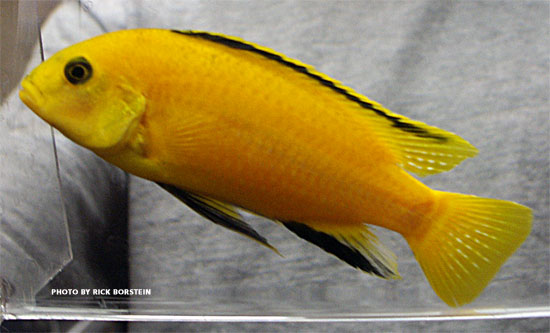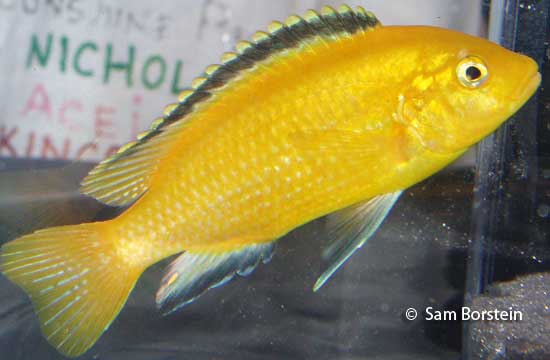Labidochromis caeruleus
Fryer, 1956
Yellow Labidochromis, Electric Yellow
Synonyms: Labidochrmois tanganicae, Labidochromis sp. "Yellow"

Above: A male Yellow Lab. Photo by Rick Borstein.
Etymology:
Genus- labis= tongs (Greek), chromis= a fish, perhaps a perch (Greek).
Species- caeruleus= blue (Latin).
Intro:
The Yellow Labidochromis is a mainstay in the hobby. I have never gone into a pet store that sells fish and not seen it for sale. This is for a very good reason. The Yellow Labidochromis is a beautiful fish, with a rich golden-yellow color with dark blue-black fins. Everyone can see the beauty of this fish. This fish has been around a while, being first typed by fryer in 1956. The fish that the species was originally described from was white, with blue fins. This fish gets its name from the blue fins, as caeruleus means blue in Latin. Electric Yellows have a lot of different location types, each yielding a slightly different morph.
The Labidochromis caeruleus color morphs are
- White with blue fins- This fish is from Nkhata bay, and is becoming very popular now.
- White- From Lundu Island
- Yellow with a blue dorsal- From Kakusa
- Lion's Cove- This is the most popular in the hobby.
- White with dark blue bar- This fish comes from Undu Point.
- Albino
*Note*-This fish is in-bred a lot, so make sure you are buying good ones. As these fish are in-bred, their color begins to turn less spectacular and they may look a little blotchy.
Distribution:
These fish are from the above locations in Lake Malawi. They are usually found in the rocky habitat.
Size, Maturity, and Sexual Dimorphism:
Size: Males- 6 inches, Females- 4 inches
Maturity: 2 inches
Sexual Dimorphism: Males are larger than females, and males develop blue in the anal and pectoral fins, while the females generally have white in these fins.
Care:
Another reason that Electric Yellows are popular is because they are easy to keep. This fish is not aggressive, and gets along with almost everybody. I recommend a trio for a 40 gallon. I kept a group of five large Yellow Labs in a 75 community with no problem. Do weekly water changes and the fish will love you.

Above: Yellow Labidochromis. Photo by Sam Borstein.
Diet:
This fish is an insectivore, but feeding a decent amount of fibrous foods is a good idea. A diet consisting of a few quality flake foods and pellets will suite them well.
Breeding:
This fish took me some time to breed. I started out with 6 Yellow Labs that I bought at a GCCA auction. At the time they were 1.5-2 inches. They were close to breeding. They never even showed breeding interest. That is when I was finally told that only females have blue in the anal and pectoral fins. I eventually bought 14 more to make my group 20 fish in total. The tank was crowded, but I was determined to breed these fish. Believe it or not, they all had strong blue coloration in the anal and pectoral fins. I'm still baffled at how out of 20 fish I got all males. I then asked GCCA member Ric Perez if he had any females. He said why, and I told him the story. He was amazed, and said that one of his larger fish just killed his last male, and he could use some more. I kept the dominant male and three other males, gave Ric the sub-dominant and another male, and gave the rest to a local pet shop. Ric gave me the two females. They were huge at about 5-6 inches. Sure enough, two weeks later they bred.
I stripped the female and was raising the fry for a BAP. The yellow L. caeruleus fry are usually brown-beige in color until they reach close 3/4 of an inch.
*Note*- I have talked to some other people about my troubles getting a female Labidochromis caeruleus and they said they had some trouble also. I think this could do with water parameters, as it does with the sexes of other baby fish. Another reason I think this happened is because people will occasionally only sell males or extra males they have because they need to free up room and also because the more colorful the fish the better it sells.
Conclusion:
This is a beautiful and great fish to keep. If you are just getting into cichlids, you should really try this fish, and you should have no problem getting it. This is one of my favorite fish just because of its color.
References:
- Konings, A. (2007) Malawi cichlids in their natural habitat. 4th ed., Cichlid Press, El Paso, Texas, 424 pp.
